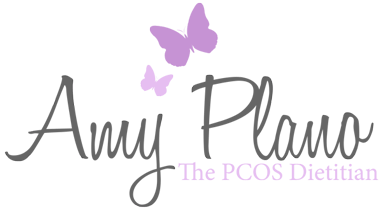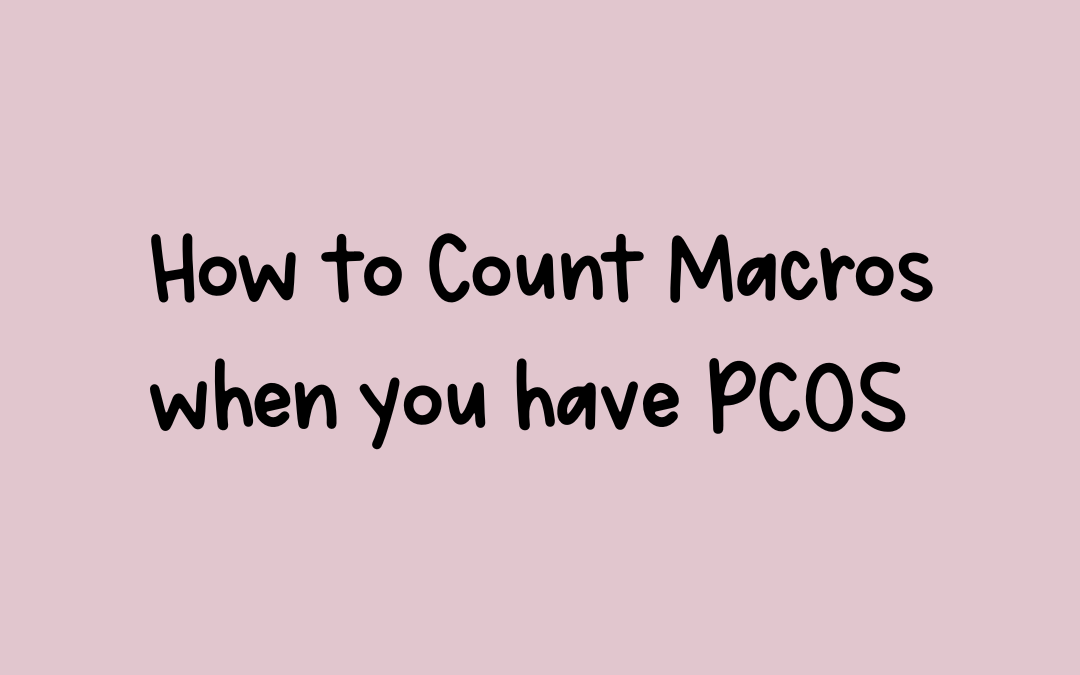
by AmyPlano | Jul 23, 2019 | PCOS and carbohydrates, PCOS and Fats, Uncategorized, Weight Loss
How to Count your Macros when you have PCOS
Learning how to count your macros when you have PCOS is a hot topic! But, before I walk you through how to do this – I need to explain what the heck macros are in the first place. Macros or more properly known as macronutrients represent the amount of the three nutrients: carbohydrates, protein and fat you need to consume to reach to achieve your dietary goals. These values are expressed in grams and are all based on the amount of calories you consume daily.
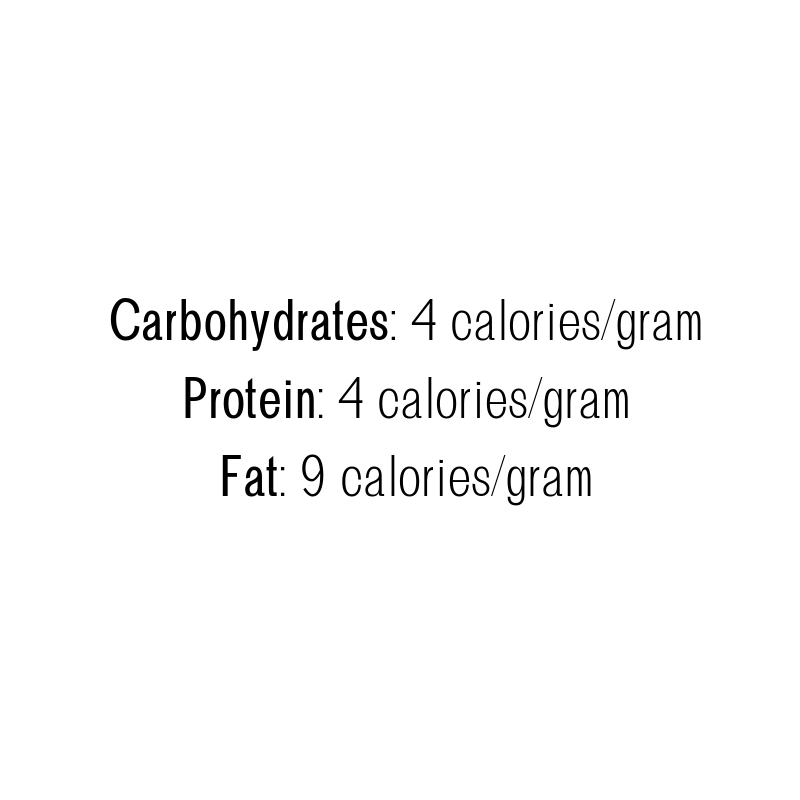
In order to determine our macros when you have PCOS, you need to know how many calories you should be consuming. In addition, you need to know the percentage of each macronutrient you should be consuming daily. The PCOS Dietitian suggests the following breakdown:

So, basically when someone tells you they are, “Counting their macros,” this simply means they are counting and tracking the amount of carbohydrates, protein and fat they take in each day.
Calories
Before we determine how to count your macros when you have PCOS we need to talk a bit about calories. While everyone with PCOS has different dietary goals, most women are seeking weight loss. Therefore, for the premise of this blog, we are going to base the calories and macros on the short-term goal of weight loss.
However, as you can imagine determining your calories for weight loss when you have PCOS is not a simple process. Your calorie needs are just as unique as you are! Your calories for weight loss depend on many variables including your: age, gender, height, weight, body fat, physical activity level, type of job and even your sleep patterns. Therefore, I would highly recommend meeting with a Registered Dietitian who specializes in PCOS to either have your metabolism tested or just to obtain some guidance on how to determine your personalized calorie needs.
In order to illustrate how to count your macros when you have PCOS, we are going to use a calorie amount of 1,400 calories per day. This would likely be a good starting point for a 25 year old female who is 5 feet 4 inches, weighs 180 pounds, is around 30 percent body fat, works out 3 times per week doing cardio 30 minutes per session, has a sedentary desk job and gets around 5 to 6 hours per night of uninterrupted sleep. Once again, your needs will likely be different, but I am using 1400 calories to provide a concrete example of how to determine your macros.
Carbohydrates and PCOS
Not surprisingly, the majority of food we eat is typically made up of carbohydrates? Carbohydrates provide energy for the body. The two main types of carbohydrates – are simple carbs (SC) and complex carbs (CC). SC occur naturally in the foods we eat. They are foods like yogurt and milk products, fruit and honey. SC are also added to food when it is processed. Examples of foods with added SC include soft drinks, cookies, ice cream, most granola bars and candy. Conversely, CC are considered more nutrient dense as they contain more fiber, vitamins and mineral than SC. Complex carbohydrates include foods made from whole grains like rice and pasta as well as legumes (beans, lentils and peas) and starchy vegetables like corn and winter squash.
In our bodies SC break down very quickly. They enter the bloodstream almost immediately causing a spike in blood sugar. This in turn prompts a rapid increase in insulin. Consequently, eating too many SC can exacerbate the symptoms of PCOS by worsening IR and facilitating weight gain.
Conversely, complex carbohydrates can improve insulin resistance as they slowly release glucose allowing for optimal insulin regulation. Due to their slow absorption rate, CC promotes an increased sense of fullness and satiety. That is why I encourage the majority of your be complex carbohydrates.
How to Determine your Carbohydrates Macros when you have PCOS
When you have PCOS, I generally recommend keeping carbohydrates under 40 percent of your total calories. This would mean if you were following a 1,400 calorie diet, you would should be consuming 140 grams of carbohydrates or less per day.
How did I get to that number? Let’s take a look at my math.

Protein and PCOS
Protein is essential. It is pretty much required for every single structure and action in the body. Everything from your hair, nails, skins and bones to your ligaments, hormones and enzymes are composed of protein.
Protein is derived from animal foods like meat, poultry, pork, fish, seafood, eggs and dairy. Plant based proteins include legumes, nuts and soy.
Protein takes longer than carbohydrates to digest and confers a sense of satiety. Also, generally protein by itself doesn’t require much insulin to be processed. This is because protein is not converted to glucose. Hence, protein does not raise insulin like carbohydrates. That is why I often recommend including a small amount of protein with your meals and snacks. This helps stabilize blood sugar and improves your overall insulin response.
How to Determine your Protein Macros when you have PCOS
When you have PCOS, I generally recommend keeping carbohydrates at around 30 percent of your total calories. This would mean if you were following a 1,400 calorie diet, you would should be consuming around 105 grams of protein per day.
How did I get to that number? Let’s take a look at my math.
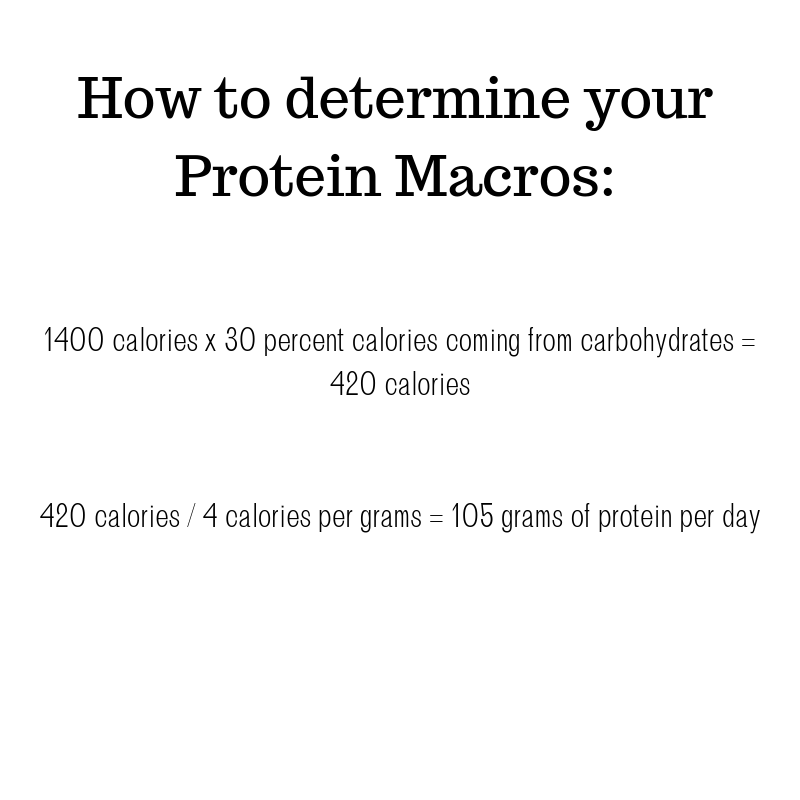 Fat and PCOS
Fat and PCOS
You might be wondering exactly where fat fits into a healthy lifestyle for PCOS. Despite its demonization, fat is an important part of our diet. Fat supports and cushions our internal organs, helps to regulate body temperature, and allows for proper absorption of several vitamins. Fat also provides the building blocks for many of our sex hormones. Fats are found in a variety of food from butter and oils to dairy products, meats and processed foods.
The right types of fats when carefully consumed can help improve insulin levels. Like protein, dietary fat alone doesn’t require insulin because it doesn’t breakdown into glucose. It also helps keep us satisfied longer thereby reducing overeating. Fat also has the unique ability to provide an increased palatability and mouth feel carbohydrates and fat don’t.
However, in spite of its many awesome insulin-lowering qualities you can’t eat as much fat as want. In fact, diets high in certain types of fats can actually contribute to IR, heart disease, hypertension and certain types of cancers.
How to Determine your Fat Macros when you have PCOS
When you have PCOS, I generally recommend keeping fat at around 30 percent of your total calories. This would mean if you were following a 1,400 calorie diet, you would should be consuming 47 grams of fat per day.
How did I get to that number? Let’s take a look at my math.
 Conclusion
Conclusion
Everybody and their mother is counting macros these days and you can too! All you need to know is how many calories per day you need to consume to meet your dietary goals. Then you simply apply the percentages 40, 30 and 30 respectively for carbohydrates, protein and fat. Lastly, you divide these values by each nutrient’s calorie value to arrive at your macronutrient amount in grams. Therefore, using the example noted above for someone following a 1,400 calorie diet their macros would be as follows:

Diet is critical in effectively managing PCOS. The foods we consume have a significant impact on our hormones. Balancing your hormones is critical to having an optimal metabolism. Since it is obvious that the underlying cause of PCOS is hormonal imbalance, it is not surprising that diet can impact the symptoms and metabolic consequences of PCOS. Determining your macros when you have PCOS isn’t difficult it just takes a little math! Macro patterns like the ones discussed in this article that support lower insulin levels should be an integral part of healthy diet for PCOS.

by AmyPlano | Jul 17, 2017 | PCOS and carbohydrates, PCOS and Fats, PCOS Breakfast Foods
PCOS Friendly Bread – Yes It Does Exist
I know what you are thinking – the word PCOS and bread should not even be in the same sentence. But guess what? That is where you are wrong ‘cysta! I have been dying to share with one of my favorite PCOS friendly breads – Dave’s Killer Bread. Yup – I agree with you! Super, duper, cheesy name. But all situations aside I will let this goober get away with it as it just that good.
I feel like I must have read a review about the bread a while back. Shopping at Shop Rite in Milford, CT a couple of weeks ago – the bread seemed to jump out at me. The label is memorable for sure! Most breads don’t have a long-haired dude strumming a guitar on the front of the package. SO I guess I am not super surprised I was drawn to it. Are you? Of course – being the foodie that I am — I needed to try it. So, of course I bought all three different types that Shop Rite had.

Front of the label for Dave’s Killer Bread – go get yo’self some.
Dave’s Killer Bread Claim to Fame
Independent of its taste – which I will get to in a second — Dave’s Killer Bread has several great characteristics that make it one the few PCOS friendly breads I trust. Number one, the ingredients are all high quality. They only use USDA organic ingredients. They also claim all their ingredients are made from non-genetically modified seeds. It is important to note that the label claim “Non-GMO”claim is not yet supported by FDA. However, usually a third-party does come in verify the validity of this claim. So, you have to give Dave props for going through all that effort to do this.
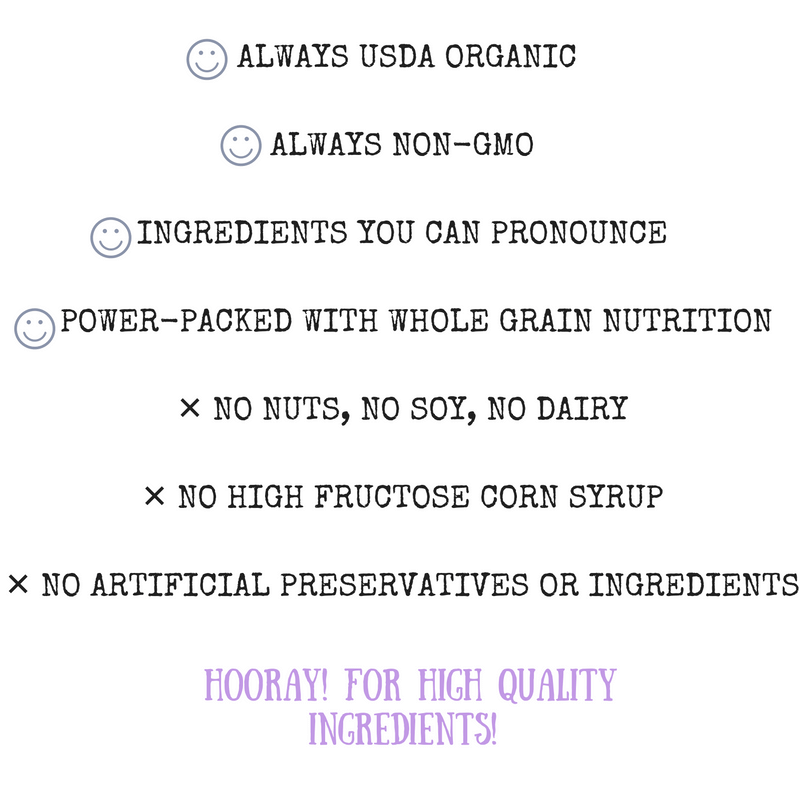
Only Ingredients You Can Pronounce
Next, I promise, you can pronounce all the ingredients. In addition to being able to pronounce them – you easily can find what they are. I reviewed all the varieties of Dave’s Killer Bread and there was not one single ingredient I had to question. Below you can see the ingredients I took directly off a loaf of Dave’s Killer Bread – 21 Whole Grains & Seeds. Remember when purchasing bread you always want the word “whole” to appear within the first 3 ingredients. This signifies the ingredients are in fact made from whole grains and not processed. As you can see – this bread fits that criteria.
The Macronutrient Breakdown is Solid
PCOS friendly breads are hard to come by – but Dave’s Killer Bread makes it both easy and tasty to accomplish this task. Dave’s Killer Breads sells several different variety. But one of the things I like is there is an entire line of thin-sliced breads that deliver the same killer taste and texture in a smaller, lighter package. One slice of the regular bread has about 120 calories, 22 grams of carbohydrates, 2 grams of fat and 5 grams of protein. While the thin-sliced variety only have 60-70 calories (depending on which one you choose), 12 grams of carbohydrates, 1 gram of fat and 3 grams of protein.
I know what you maybe thinking – how thin is thin? Not too thin – I promise. I often cringe when people tell me they eat “diet bread” (the first thing that comes to mind is Sara Lee – yuck!) that is paper-thin. Why even bother? Put that crap in the toaster for too long – and you have a three-alarm fire. That is not at all what I am talking about.
In all seriousness, I did not even consciously buy the thin-sliced bread. I just bought what they had which happened to be the thin-sliced variety. I did not even noticed it was thin-sliced until it was all gone and I needed to go to the store to buy more! It was only then that I noticed that Dave even made what they would consider a traditional, thicker slice. I bought that too and it was as good – but not drastically different from the thin-sliced variety. So there is no need to “upgrade” to the big girl slice — unless you want the extra calories and carbohydrates.
Did someone say fiber?
You know how much I love talking about the benefits of fiber for women with PCOS. If fact, I think my patients want to kill me sometimes when I hammer them about meeting their daily fiber targets. Which for most folks is a whopping 28 – 35 grams of fiber per day. The average women only consumes about 15 grams – 50 % less than what is required. And we wonder why we are hungry all the time!?! Not only does fiber help keep us full, it also helps control blood sugar by promoting the liver to release blood sugar more slowly. Given that women with PCOS are more likely than not to have issues with their regulation of blood sugar and insulin there is no reason they should not be meeting their fiber goals.
Dave’s Killer Bread helps us get one step further to meeting our fiber needs. Each slice of Dave’s Killer Thin-Sliced Bread has 3 grams. So if you make yourself a pretty little sandwich you have yourself 6 grams of fiber. While, that may not seem like a lot – once you start adding all sorts of good-looking veggies to your sandwich you are well on your way to meeting your daily fiber totals. Round out the meal with some guacamole or humus with raw veggies and well what can I say – you’ve got yourself a nice high fiber meal.
Baby Got Omega-3s
Does the word Omega-3s ring a bell? Remember a couple of weeks ago when we were chatting about all the amazing benefits of fats for women with PCOS? Well, if you missed it – or maybe just forgot click here to read more about PCOS friendly fats. Omega-3 Fatty Acids are a specific type of polyunsaturated fat that is essential to our body. This means our body cannot produce them – so we need to get them from the food we eat. Omega 3’s are most known for their role in reducing inflammation.Plus studies support that the right levels of Omega 3’s can reduce cholesterol, triglycerides and blood pressure, lowering your chance for heart attack, stroke or other cardiac event.
Dave’s Killer Bread is one of the few breads on the market to actually contain Omega 3’s that I know of. I imagine other exists – they have just yet to cross this girl’s path! Each slice of the thin-sliced variety has 130 mg per slice. While there is no finite recommendation for Omega 3 intake, it is fair to say that more is almost always better. While we would love to see people eating fatty fish that has Omega 3’s, I think it is fair to say this is not happening. So if someone can squeak in some Omega 3’s in – especially in an assuming source such as bread – I am all for it. Top your bread off with some grass-fed butter (Kerry Gold is my absolute favorite!) or organic nut butter and you just jacked up your Omega 3’s without batting an eye. Boom!
Dave’s Killer Bread Has a Killer Mission
I admit it – I am a sucker for a anyone or company who gives back. I don’t care what you are giving back – whether it be shoes, money, time, hugs or just smiles I think it is just great when people try to make some else’s life better. Companies like Toms Shoes, The Company Store and Good Spread have a place in my heart. Not to mention amazing people like Theresa on Pit Bulls and Paroles who rescues and finds homes for thousands of pit bulls each year. It is amazing how selfless companies and regular people alike can actually be. Especially in this day in age when everyone seems to be drinking their own flavor of hater-ade.
Well, the Dave’s Killer Bread company has an equally heart warming story. The company states that one in three of their employee partners has a criminal background.
“At Dave’s Killer Bread, we believe everyone is capable of greatness and that a second chance can lead to positive lasting change. In 2015 we introduced our non-profit, the Dave’s Killer Bread Foundation, with the mission to inspire other businesses to become Second Chance Employers and affect positive societal change. “
They even have a foundation for reducing the negative impact of mass incarceration and recidivism in America. Their foundation provides programs for businesses looking to adopt or improve these practices. I am mean honestly how cool is that?
Now the moment you have all been waiting for – how does Dave’s Killer Bread taste? I think it tastes pretty awesome! If I were to use one word to describe the bread it would be ‘hearty’ yet not overly heavy and dense. Despite being a whole grain, Dave’s Killer Bread still retains a good deal of lightness. I found it soft with a very light sweetness. Obviously, depending on the variety you buy you may have more or less seeds. I found it was good on a sandwich and just as good on its own with butter or peanut butter. I even made French toast with it which came out quite awesome if I have to say so myself!
But just a quick word of caution – do check the expiration dates. The first couple of loaves we bought were killer literally. But the second batch seemed a little dryer – if not slightly stale. A quick little pop in the toaster remedied that. However, I might pull from the back of the shelve as most stores likely do first in – first out placing the older ones in the front.
So that’s a wrap for this week’s blog. Have you tried Dave’s Killer Bread? Or do you have a PCOS Friendly Bread you recommend? Please let our PCOS community know in the comments below. We would love to hear from you!


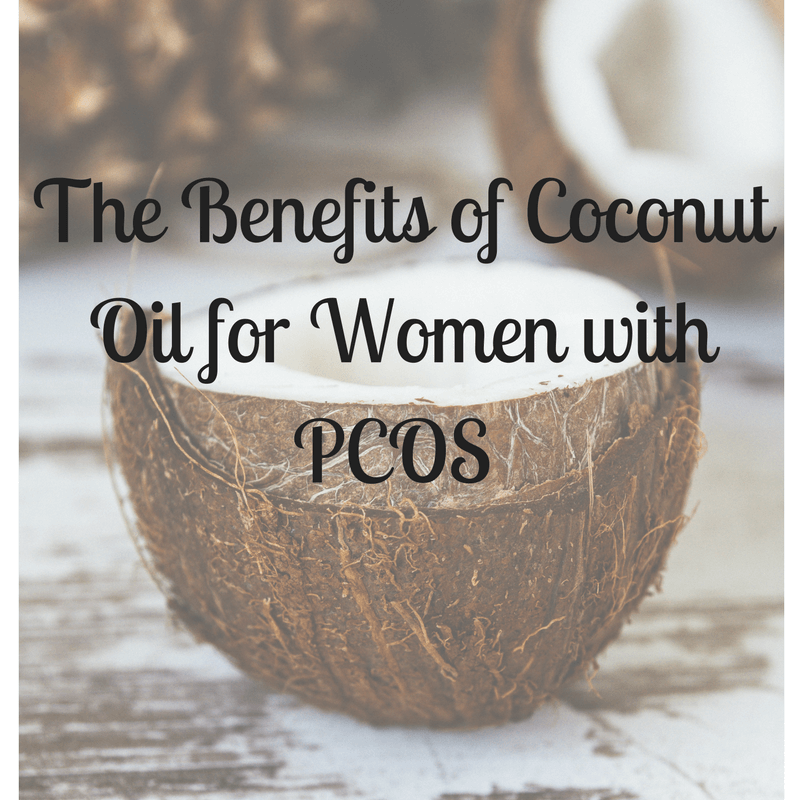
by AmyPlano | Jan 6, 2017 | PCOS and Fats, Weight Loss
The Nutritional Benefits of Coconut Oil for Women with PCOS
Did you know there are many nutritional benefits of coconut oil – especially for women with PCOS? In this blog, I discuss the nutritional benefits of coconut oil, what terms to look for when purchasing, as well as how to incorporate coconut oil into your current PCOS lifestyle. If that is not exciting – then I don’t know what is 🙂
It seems like no matter where you turn – social media, twitter, newspapers (yes, they do STILL exist!) or even your best friend – someone is talking about coconut oil. They may not know what they are talking about – but they are still talking!
Some folks say coconut oil is “bad” while other experts tout it as the next superfood. So what’s a girl with PCOS to do? Should you go out and buy jars of it? Or should you drop it like it’s hot and hope everyone stops talking this tropical oil?
Well fret not ‘cysta! The PCOS Dietitian is here to give you the 411 on coconut oil.
What the heck is Coconut oil?
To make coconut oil, manufacturers press the fat out from the white “meat” inside a coconut. Coconut oil consists mostly of saturated fatty acids. When most people think of the word “oil”, they think of a liquid fat like olive or avocado oil. However, due to its saturated nature, coconut oil it is actually solid at room temperature! If you have never seen it before, it actually looks pretty similar to shortening. However, thankfully it has none of the icky properties of that yucky oil!
Soooooooooo … I know what you are thinking. You just heard the nasty word saturated fat and you are officially in freak out mode. Hang in there ‘cysta I have some good news that is going to blow your mind.
The Super Hero of Coconut Oil – Medium Chain Triglycerides
Coconut oil’s saturated fats are primarily composed of medium chain triglycerides or more commonly known as MCTs. MCTs behave differently than other saturated fats in the body and because of this factor have a positive effect on many of the systems in the body.
Warning – it’s about to get nerdy! Skip this paragraph if you just want the ‘cliff’ notes version! MCTs get their name because of the length of their chemical structure. All types of fatty acids are made up of strings of connected carbon and hydrogen atoms. Fats are categorized by how many carbons they have: short-chain fats have fewer than six carbons, medium-chain fats have between 6–12 carbons and long-chain fats have between 13–21 carbons. Why do we even care about this nonsense you ask? Well because they are smaller, MCTs get into our cells easier and are quickly absorbed.
MCTs are powerhouses. They have soooooo … many benefits!

So many benefits of MCTs
MCTs can help promote weight loss, decrease hunger, stabilize blood sugar and enhance immune and cognitive functions. Many studies also support MCT’s role in thyroid health. MCT oils have multiple benefits relating to cardiovascular health such as the ability to decrease total cholesterol as well as triglycerides.
What KIND of coconut oil should I buy?
Just like everything in the food industry today, some coconut oils are healthier than others. Two types of coconut oils exist – refined and unrefined. Can you can guess which one is the healthier of the two!?!
Refined Coconut Oil
Refined coconut oil is subjected to various chemical solvents, deodorizers and bleaches. In the refining process, coconut oil is exposed to high temperatures. Many of the refined coconut oils on the market also contain trans fats. Trans fats have a negative impact on heart health. Refined coconut oil is tasteless, odorless, and no surprise has a lower nutrient content. Avoid refined coconut oil like the plague.
Unrefined Coconut Oil
On the other hand, unrefined coconut oil aka virgin coconut oil, extra-virgin coconut oil or raw coconut oil is unadulterated. It is minimally processed which means it has a higher nutrient content. When you open up a jar of coconut oil – it smells like it should – like coconuts! If it is does not smell like coconuts, it is likely refined.
Additional terms to describe coconut oil
You may also hear the terms “expeller-pressed coconut oil” and “cold-pressed coconut oil.” Expeller-pressed coconut oil goes through a harsher process at a higher temperature which results in a loss of nutrients. Cold-pressed coconut oil is processed at a lower temperature and the greatest amount of nutrients are preserved.
Lastly, you want to see the term “organic” on the label as well. This guarantees that the oil is not produced through genetic engineering.
So, in short, look for the words organic, cold-pressed and unrefined when purchasing coconut oil.
Where can I buy coconut oil?
You can find coconut oil at most grocery stores, health food stores, and even some drug stores. In grocery stores you can find it in the natural foods aisle. I have also pleasantly seen coconut oil in stores like Costco, Trader Joe’s and even TjMax! Depending on the size, coconut oil can cost anywhere from $6.00 – $20.00 per jar. Make sure it is solid not liquid when you buy it. Keep it in cabinet to decrease its exposure to light or high temperatures. When the temperature is above 75 degrees – the coconut oil turns into an oil! So be careful.
How can coconut oil specifically help women with PCOS?
Unrefined, organic coconut oil has the potential to help women with PCOS in a variety of ways. Below are just a couple of the what I feel are the most important benefits.
Blood glucose levels. Many women with PCOS often experience unstable blood sugar levels. This can lead to dizziness, irritability, fatigue and increased hunger. Coconut oil can help stabilize blood sugar levels. Some studies have also demonstrated that coconut oil can also have a favorable impact on insulin secretion. Double win!
Improves blood lipid profile. The risk of getting heart disease increases when you have PCOS. Coconut oil can help raise levels of HDL (along with a consistent exercise program, of course!) or what we call our good cholesterol. It also can help reduce the level of fat (triglycerides) in the blood. (But be mindful it can also raise LDL cholesterol – or your lousy cholesterol – a number which you want low!) This is especially beneficial for women with PCOS ♥
Helps with hypothyroidism. While thyroid issues do not soley exist in this demographic, they can nonetheless be extremely problematic in women with PCOS. Coconut oil helps improve thyroid function and speeds up fat breakdown.
Weight maintenance. By nature of the syndrome, women with PCOS have an increasingly difficult time keeping the weight off. Since coconut oil is a source of fat, it can help you feel full and keep your weight at bay.
Summary of the key attributes of coconut oil for women with PCOS ♥♥♥
stabilizes blood glucose levels
Improves blood lipid profile
Helps with thyroid regulation
Promotes an ideal weight
Like with any type of fat, you always need to proceed with caution. Coconut oil is no exception to this rule. Every tablespoon of coconut oil is 120 calories and 13 grams of fat. These calories can add up pretty quickly! So while I sincerely believe there are some great benefits to coconut oil for women with PCOS I would urge you to use it in place (NOT in addition to!) of the fat you are using in your diet.
More so, it is important to be crystal clear that I am also not advocating coconut oil as your only source of dietary fat. The PCOS Dietitian ♥ variety! So please just throw it into the “mix” and expose yourself to all the different nutrients present in this oil. Start slow – only with about 1 teaspoon at a time. When consumed in large amounts too quickly coconut oil can cause diarrhea. And I don’t know anyone who enjoys diarrhea 🙂
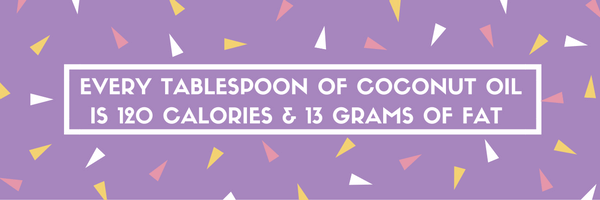
Now, that you know all the benefits of coconut oil, here are some different uses:
Cooking or frying. You can use coconut oil as the base of the pan when cooking or frying your favorite dish. It is especially good in a stir-fry! Many of my patients even like it in scrambled in their eggs!
Baking. You can use coconut oil in recipes to make sure your baked good come out nice and flaky. Make sure to melt the coconut oil first! Then you can use it in its liquid state to replace vegetable oil and butter in recipes.
Smoothies. One of the things I often put on my patient’s meal plans are smoothies. I always like to include a source of fat into smoothies. I find that smoothies are much more satisfying with fat! While peanut butter is often my go-to choice for chocolate based smoothies, I prefer coconut oil for fruit-based ones. I recommend putting about 1 tablespoon in a small glass cup and putting it in the microwave for about 15 seconds. This will liquify the oil. Then you can add it directly into the blender when making your smoothie.
Coffee or Tea. Coconut oil can make a great addition to your coffee or tea in the morning. We refer to this drink as bullet proof coffee. I know it sounds crazy but just try it! It makes the coffee super-duper creamy. Yum!

And … when in doubt – eat it by the spoonful.

There is no shame in taking a good ol’ spoonful of coconut oil. I guarantee it will make you smile. Just like these happy little spoons 🙂
If you are not a big fan of cooking or baking, you can get the same benefit by eating one spoonful of coconut oil per day as you would by using it in your meals.
In addition, topical coconut oil has been shown to have a positive effect when rubbed consistently on thinning hair related to PCOS. While I am only familiar with the dietary aspects of coconut oil, it seems like this often pops up in my reading. So I felt like it was fair to throw that out at you especially if hair loss is something you struggle with.
So I hoped you learned a thing or two about coconut oil. When consumed in addition to other heart health fats like olive oil, grass fed butter, nuts and avocados – coconut oil has the potential to have a positive impact on PCOS symptoms. While I am by no means advocating it as a “cure” for ALL PCOS symptoms – it certainly has the potential to help with some of the major ones like dyslipidemia, hypoglycemia, elevated weight and hypothyroidism. So please give it a try – I am pretty sure you will enjoy it! And remember – always buy organic, virgin (or extra-virgin) cold-pressed if you can and skip the refined stuff!
Are you a coconut oil fanatic? Do you have some fun, exciting ways to incorporate this oil into your diet? Our community would love to hear your thoughts. Please let us know in the comments below how you using coconut oil.


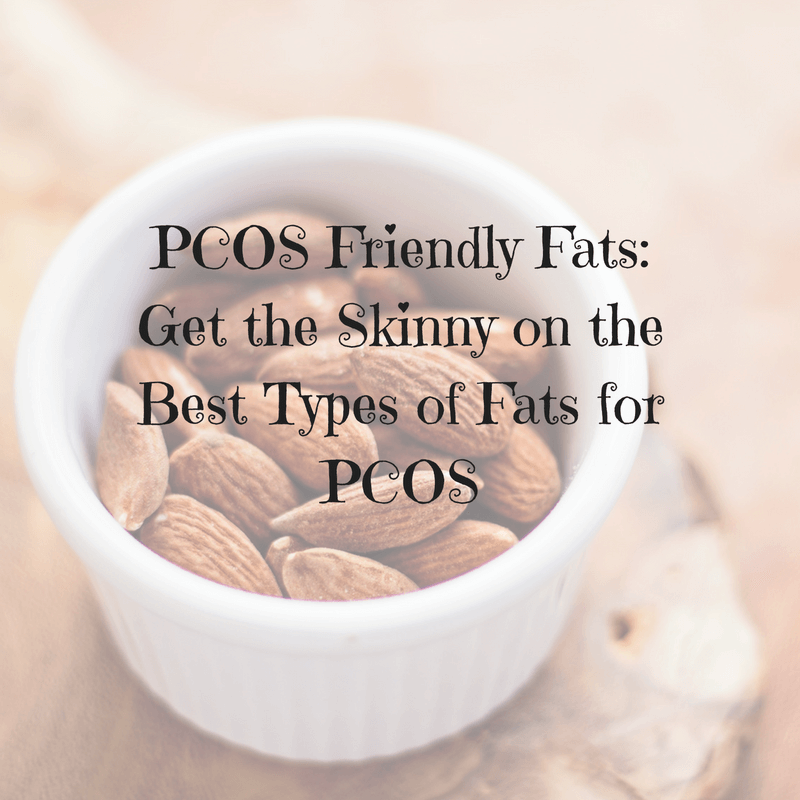
by AmyPlano | Oct 28, 2016 | General information about PCOS, PCOS and Fats, PCOS friendly recipes, PCOS snacks
PCOS Friendly Fats
Did you know that there was such a thing as PCOS friendly fats? Well, if you didn’t thank goodness you landed on my page! I am so happy to have YOU!
There is no denying that fat should be an integral part of any women’s diet. But this is especially true for the diets of women with PCOS. For these amazing women, eating fat (and the right type!) is actual critical to their overall health. There are SO many ways dietary fats are beneficial. Where the heck do I even begin!?!
Number one, they give your body with energy to support cell growth. They also help protect your organs and help keep your body warm. Fats also help your body absorb vitamins, mineral and important nutrients. They also form the backbone of your sex hormones. This last part is especially important, as we know PCOS is a disorder marked by imbalances in hormones. If women don’t take in enough fat then they don’t have the natural resources to correct these imbalances.
Not to mention – fats made us feel FULL! And who does not want to feel full? Fats are such an important part of our diet – yet many women with PCOS tend to shy away from them. And the plot thickens ….

Did you know that women with PCOS are twice as likely to suffer from atherosclerosis than women without syndrome? Yup. This is because many women with PCOS, by nature of the disorder, have several inherent risk factors for heart disease. Many women with PCOS present with central adiposity (excess weight in the belly area), high blood pressure, high triglycerides and low ‘good’ cholesterol levels. All of these risks significantly raise their risk heart disease and stroke.
SO I know what you are probably thinking …

Believe me on this one, cysta!
The simple answer – “Absolutely!” But fret not, the PCOS dietitian is here to give you the skinny on the best types of fats to include in your diet. But I will warn you – the explanation is anything but simple. You see, it critical to note that not all fats are created equal. Some are better for us than others. But even saying that is oversimplifying fats. The quality of fats are dictated by where they come from, how they are processed, raised or prepared as well as additives or preservatives it may contain. All these variables come into play when we considering whether a fat “good” for us or not. In future blogs we tackle the types of fats you should avoid – but onward to the good stuff!
PCOS Friendly Fats
Monounsaturated fats (MUFAs)
Let me count the ways I love monounsaturated fats (MUFAs)! MUFA’s can have a beneficial effect on your heart by optimizing your cholesterol levels. One of the ways that MUFAs do this is that they help lower the “bad” types of cholesterol (LDL) in the blood and while increasing the “good” (HDL) kind.
Tip: When trying to figure out the two cholesterol levels remember it this way: LDL is your lousy cholesterol and you want this level LOW, while HDL is the healthy cholesterol and you want these levels HIGH.
By optimizing these two values you can lower your risk of heart disease and stroke. Furthermore, research supports that MUFAs may also benefit insulin levels and blood sugar control, which can be especially helpful for women with PCOS. Trifecta! Talk about being a PCOS friendly fat! Monounsaturated fats also offer nutrients to help with cell development and provide a good source of vitamin E in the diet. Where can you get your hands on these lovelys? The PCOS Dietitian would not leave you hanging!
Examples of Monounsaturated fats
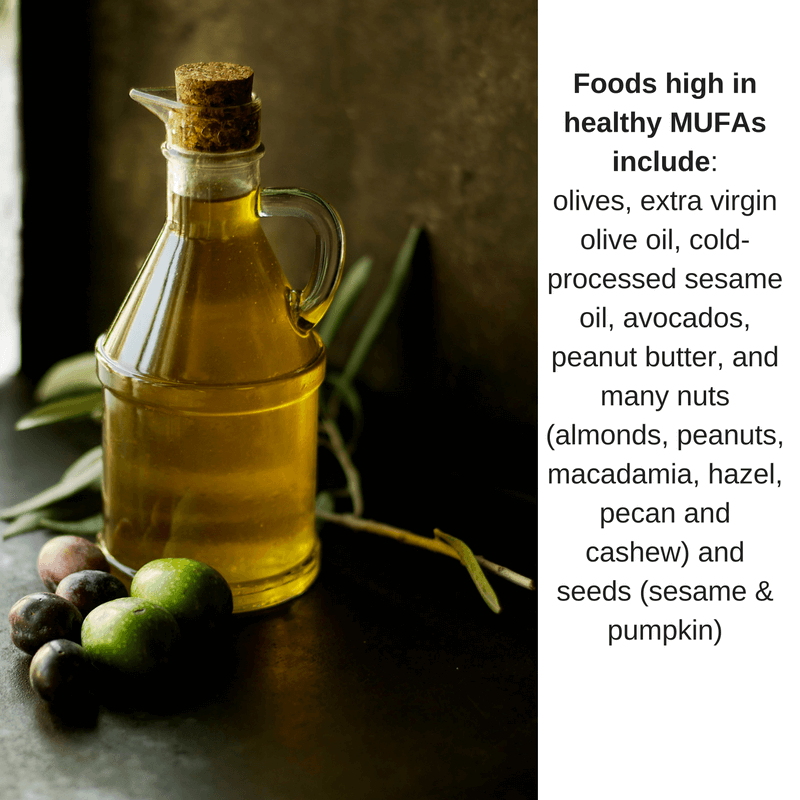
Foods high in healthy MUFAs include: olives, extra virgin olive oil, cold-processed sesame oil, avocados, peanut butter, and many nuts (almonds, peanuts, macadamia, hazel, pecan and cashew) and seeds (sesame & pumpkin)
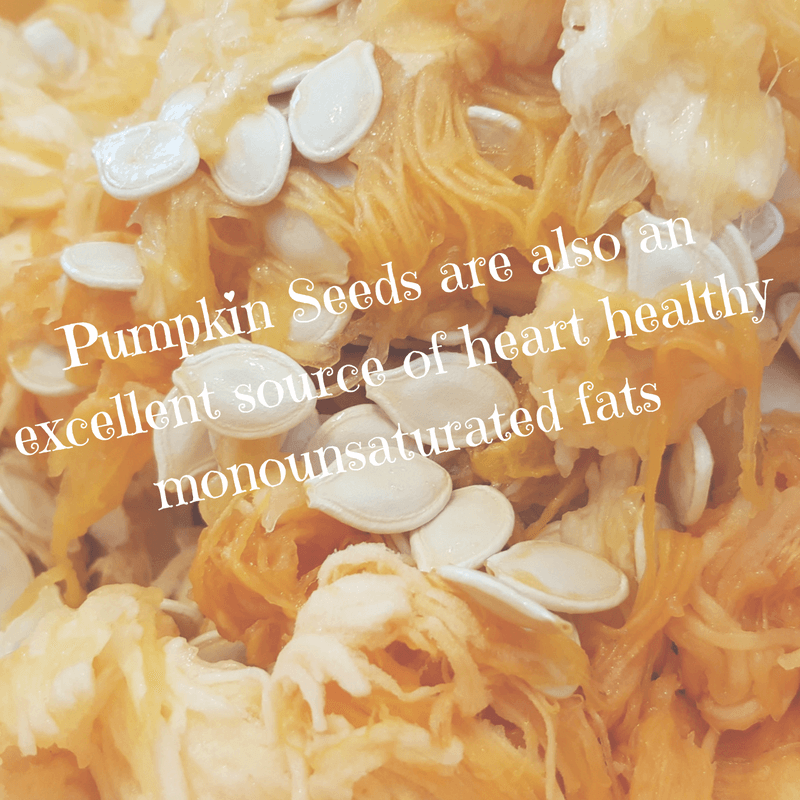
But when speaking of the good – there is always an exception to the rule – Refined Monounsaturated Fats
Canola oil, peanut oil and safflower oil are also monounsaturated fats. However, they are what I would consider modern refined processed oils. The majority of these crops are grown from genetically modified seeds. The oils are treated with high heat and toxic solvents. The processing increases the shelf life of the oils and removes most of the natural flavoring, making them more attractive for the industrial food industry. Please limit your intake of these types of oils as much as possible.
Buying tip: Most olive oils are actually blends of several oils including vegetable oils. Therefore, when buying olive oil look for the California Olive Oil Council (COOC) logo. For Italian olive oils look for (DOP), Spanish (DO) and ones from France (AOC) to make sure it is authentic.
How Much Do You Need of Monounsaturated Fats?
No need to go krazy! All fats, including monounsaturated fats, are high in calories, so use MUFAs only relative to your personalized daily fat requirements. Consume MUFA-rich foods instead of other fatty foods, NOT in addition to them! The goal for your overall fat intake should be around 25-35 % of your total calories. Monounsaturated and polyunsaturated should make up the bulk of this.
Polyunsaturated fats (PUFAs)
Well, I have to say, I have just as much love for PUFAs as I do for MUFAs. When you pour your favorite cooking oil into a pan, there’s a good chance you’re using a polyunsaturated fat. Polyunsaturated fats are used to build cell membranes and line the covering of nerves. They are needed for blood clotting, muscle movement, and for controlling inflammation. Studies support that eating polyunsaturated fats in place of saturated fats or highly refined carbohydrates reduces harmful LDL cholesterol and has a positive effect on the cholesterol profile. They can also help lower triglycerides.
Examples of Polyunsaturated fats
Examples of foods high in polyunsaturated fats include: walnuts, sunflower seeds, organic tofu, soybeans, and fatty fish such as salmon, mackerel, herring, and trout.
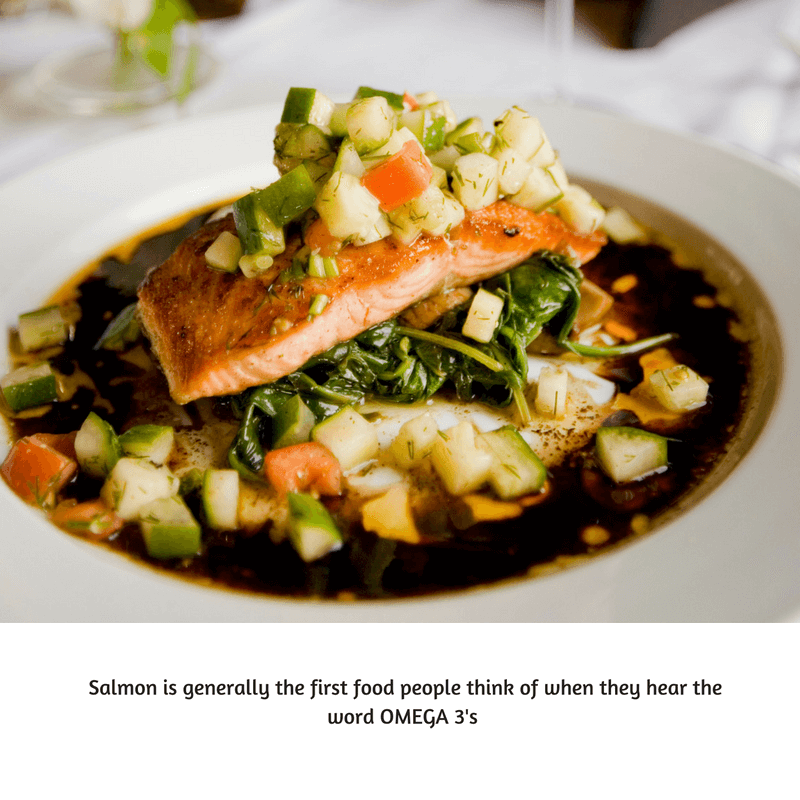
Note – just like the monounsaturated oils – canola, safflower and peanut oil – soybean oil, corn oil, sunflower oil also fall under the same ill as those modernized processed oils. They too are highly processed oils that go through an insane amount of processing with chemical solvents, steamers, neutralizers, de-waxers, bleach and deodorizers before they end up in the bottle. So please, when possible reduce their use in your cooking and limit your general consumption of foods that contain them.
Omega 3 Fatty Acids – Superstars
But on a much more positive note, I bet you have heard of the superstar Omega 3 fatty acids! Omega 3 fatty acids are essential fats the body cannot produce. Therefore, we need to consume these guys in the diet.
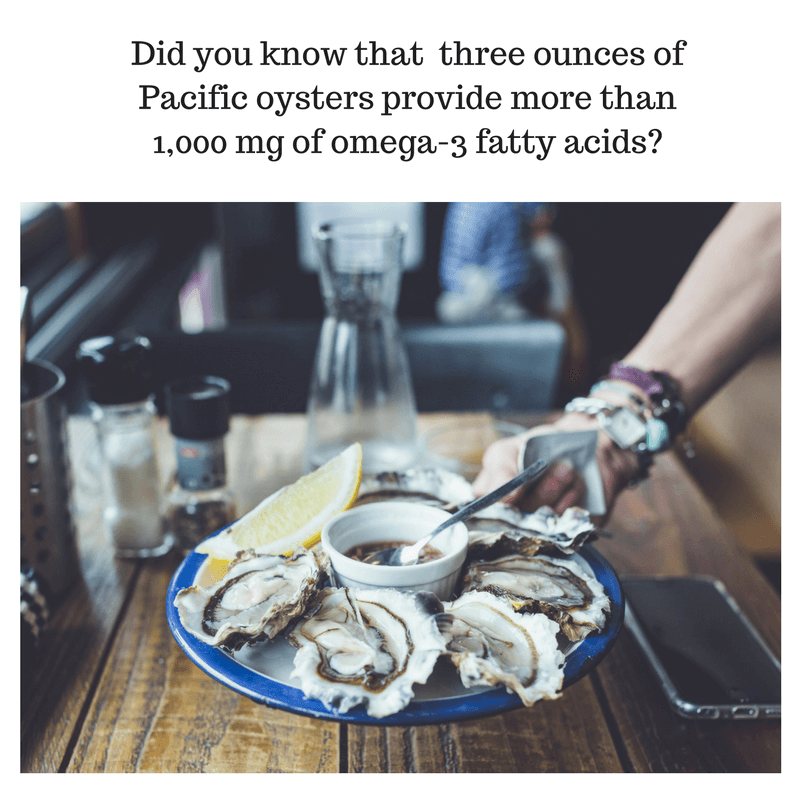
Did you know that there are three different types of omega 3 fatty acids? The three types are DHA, EPA & AHA. DHA and EPA are the preferrable form and are found in foods like cold-water fish and algae. While ALA is found more in plant foods such as nuts and seeds, as well as in grass-fed beef.
The Benefits of Omega 3 Fatty Acids
The benefits of omega 3 fatty acids are seemingly endless! When consumed in right amounts they are known to help with everything from promoting a healthy pregnancy, to decreasing the risks for depression, dementia and even memory loss. Inflammation in the body can damage your blood vessels and lead to heart disease and stroke. Omega-3 fatty acids may decrease triglycerides, lower blood pressure slightly, reduce blood clotting, decrease stroke and heart failure risk and reduce irregular heartbeats. Not too shabby, right?
Examples of Foods Containing Omega 3 Fatty Acids
Foods that are high in omega 3’s include salmon (wild caught & sockeye), herring, mackerel, anchovies, oysters, sardines, pole & line caught tuna and lake trout. Vegetarian sources include algae (seaweed) walnuts and flax.
Buying tip: Polyunsaturated fats are much more vulnerable than monounsaturated fats. PUFAs are sensitive to light, air and sunlight. Therefore, keep foods high in PUFA’s away from direct light and when permissive keep in the refrigerator to prevent them from going rancid.
How Much Do You Need of Polyunsaturated Fats?
As important as PUFAs are there is no set requirement. However, the American Heart Association recommends eating at least 6 ounces of cold-water fish twice per week. If you do not like fish or feel like you are falling short on your intake, you may want to talk to your physician about a supplement. It’s especially important to consult your health care provider if you are pregnant or breastfeeding, if you take medicine that affects blood clotting, if you are allergic to seafood, or if you are considering giving a child an omega-3 supplement.
Still stumped on how to get more PCOS friendly fats in your diet? Let the PCOS Dietitian give you some fun and fresh ideas.
Five Ways to Incorporate More PCOS Friendly Fats Into Your Diet
1. Go nuts!
Snack on nuts instead of salty, carb-laden pretzels and chips. Nuts are a great source of heart healthy fats, super tasty and even come in single serving bags. Just make sure to keep your serving to around ¼ cup which equals around 180 calories, 14 grams of fat (almost all mono & polyunsaturated!), 6 grams of protein and 6 grams of carbohydrates.
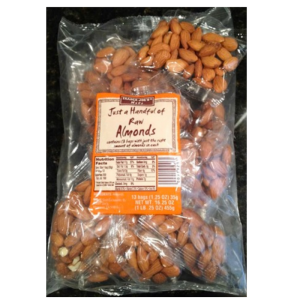
Tip: Trader Joes sells pre-portioned almonds and cashews called ‘Just a Handful of Almonds.” If you are looking for something with a bit more spice and kick the Emerald brand sells 100-calorie packs of flavored cashews, almonds and walnuts. The flavors range from Siracha, to jalapeño to chocolate and cinnamon. These are great to throw in your car, desk drawer or car. They travel extremely well.
2. Become Sandwich Savvy
Replace your cheese and/or mayonnaise on your sandwich with sliced avocado or even guacamole. This quick little swap decreases your intake of unhealthy fats while boosting your intake of monounsaturated fats. It also adds a whole new dimension to your ho-hum lunch!
Tip: It seems like it always so hard to get avocados ‘just right.’ They always seem to be too hard or too ripe. Just a quick tip if they are green and unripe is to put them in a brown bag (just like you would other fruits!) and that will speed the ripening process. On the flip side, if you have an avocado on the counter that looks perfect – but you are not ready to use it – throw it in the fridge. This will halt the ripening process.
3. Nut Butters
Nut butters – need I say more?!? I sometimes wish nut butters were a food group. If they were I would be SO in love!
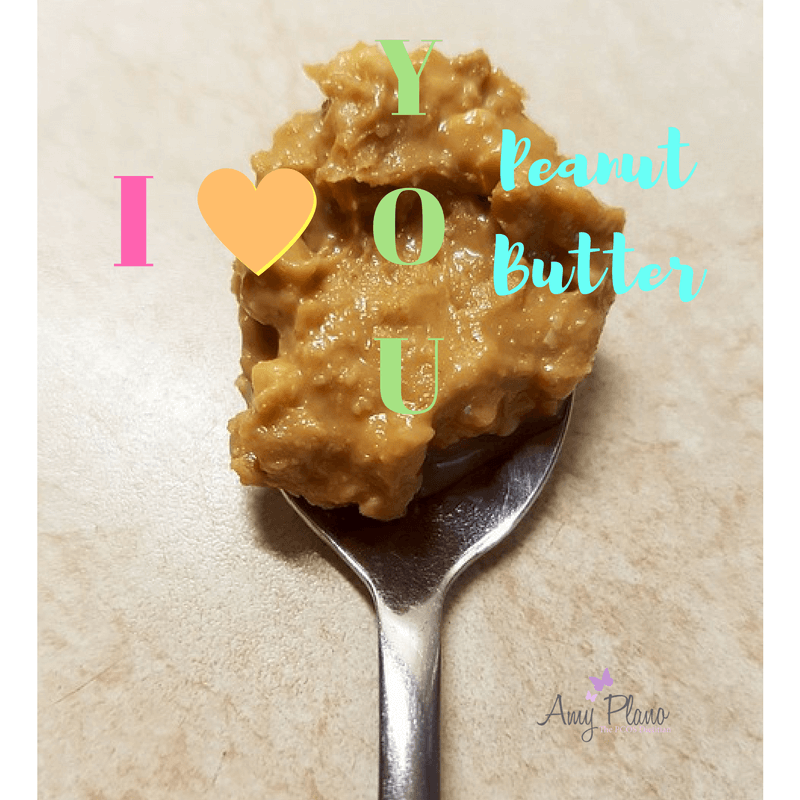
Nowadays you can get almost every nut in spreadable form. Gone are the days when you could just get peanut butter. Now you can get cashew, almond, and hazelnut butters and my personal favorite – sunflower seed butter! Spread any of these heart healthy butters on celery, apples, bananas or even swirl into your morning oatmeal. But just like any fat be mindful that each tablespoon of nut butter packs a whopping 100 calories and 6 grams of fat. Yes, it is healthy fat – but next thing you know that “little” bit of peanut turned into half the jar. Sounds familiar?
Tip: When buying peanut butter always go organic! The crops are heavily sprayed and no one needs all those chemicals in their body. Also brands such a Skippy & Jiff (unless they state they are “natural”) contain hydrogenated fats – so don’t touch those bad boys with a ten-foot pole.
4. Cha-Cha-Cha-Chia
Discover the magic of chia seeds. Chia seeds are loaded with fiber, calcium, antioxidants and Omega 3’s. They are a true super food. You can pretty much buy them in any grocery store including the obvious ones like Trader Joes and Whole Foods. A small bag goes for around $6 – $8 depending upon the brand. A small bag supplies well over 40 servings!
You can sprinkle on your yogurt, blend into your smoothies or make some killer chia pudding! See my recipe below for this tasty treat.
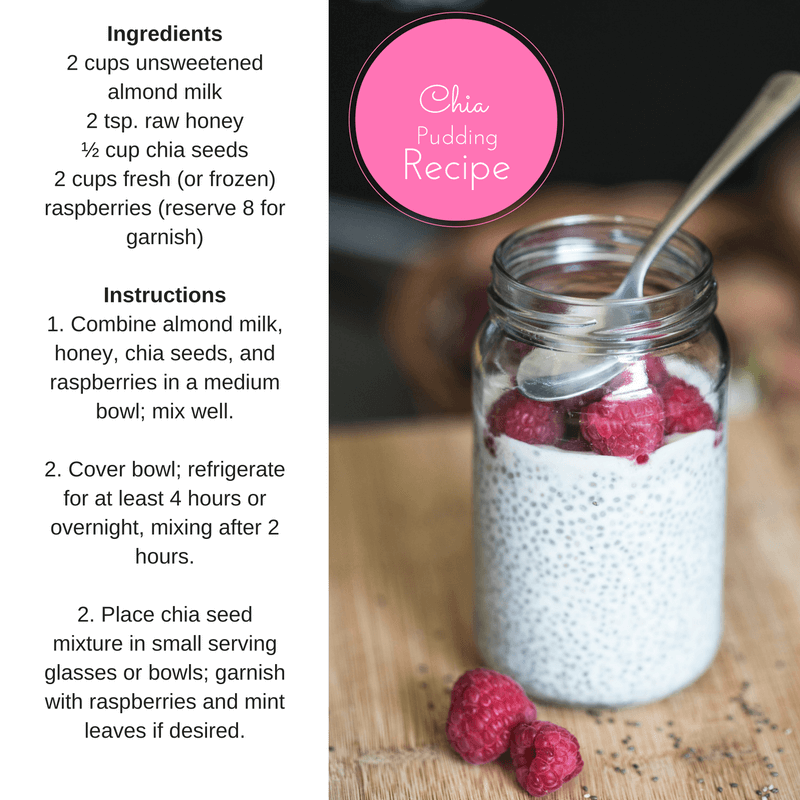
Tip: Remember what we said about polyunsaturated fats like Omega 3’s? They are vulnerable to oxidation. Storing them in the refrigerator will extend their shelf life. However, most chia seeds come in special vacuum-sealed packaging. These packages can be stored at room temperature until they are opened. Once opened, throw the whole bag in the fridge to maintain their freshness.
5. Make your own salad dressings
Making your own salad dressing is SO easy! Once you start doing this – you will be ashamed you ever bought the crap in a bottle. Plus, it a terrific way to get your PCOS friendly fats in AND your greens.
I urge you experiment with different types of oils when making your dressings. Have you tried avocado oil? It is a super mild oil that blends nicely with various vinegars, acids such as lemon and lime. How about walnut oil? It pairs awesome with balsamic and maple syrup. Check out the recipes below. You can always tweak the ingredients to suit your palate!
Avocado Vinaigrette
Ingredients:
3 tablespoon Avocado Oil
1 tablespoon Apple Cider Vinegar
1/2 clove Garlic, grated or crushed
Zest of 1/2 Lemon
1/4 teaspoon salt
1/4 teaspoon back pepper
For the Vinaigrette:
Whisk all ingredients in a small bowl. Top off your favorite bowl of salad greens!
Lighten-Up Lemon Walnut Salad Dressing
Ingredients:
1/4 cup red wine vinegar
2 tablespoons minced shallots (onions will work, too!)
2 tablespoons walnut oil
1 tablespoons REAL maple syrup (you can adjust up or down depending upon how sweet you like it!)
1 tablespoon fresh lemon juice
1/2 teaspoon salt
1/4 teaspoon freshly ground black pepper
Preparation
Combine all ingredients, stirring with a whisk. Store in refrigerator for up to 1 week. A mason jar is a great storage vehicle.
Phew that was a lot of info! Hopefully I have convinced you of all the awesome benefits of including PCOS friendly fats in your diet. Rather than shy away from, you know have the important tools to make the most educated decisions when it comes to which fats to choose to support your PCOS. But as always I would love to hear your thoughts. What are some of your favorite MUFAs and PUFAs? What are your strategies for fitting them in your diet? Tell us in the comments below!






 Fat and PCOS
Fat and PCOS Conclusion
Conclusion
